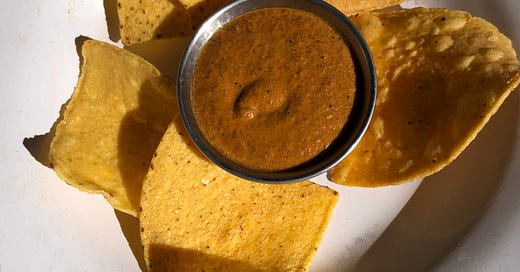Hello, how are you today? This is the 30th edition of Buzzing! If you’ve read all 30 editions, well done for making it this far. And if you haven’t, do browse the archives for plenty of food for thought (and recipes for actual food too).
Today in Buzzing:
The key to unlocking insects’ sustainability potential is to feed them waste
In Other News: Doughnuts, ethics and Israel
Test Corner: Cricket Salsa at Wahaca
In last edition’s post on the EU’s recent authorisation to include insect protein in poultry and pig feed, I mentioned how this was not the priority for all companies in the sector. A number of insect producers would in fact have preferred the EU to start with broadening the list of allowed substrates (the insects’ feed).
Let me explain: although insects could, in theory, be fed a very broad range of ingredients, including things like food waste and manure, health and safety regulations mean that in practice, that range is very small. The EU has the most stringent rules (the US and Australia are more liberal), which means that many insect producers end up using commercial animal feed 😞 or agricultural side-streams, many of which are already in high demand (such as spent brewer’s grain). I covered this in more detail last year.
The reason I am keen to revisit this issue is that Finnish academics recently published a very interesting Life-Cycle Analysis [1] that looked at the potential of insect protein to reduce food-based carbon footprints in Europe. The study had two important findings: the first is that the biggest carbon footprint reduction will come from consuming insects directly as food rather than feed (this confirms findings from previous studies).
The second is that insects can significantly contribute to reducing the carbon footprint of broilet meat (chicken) but that the key to unlocking this potential is allowing “low-value side streams” (eg food waste, manure) as feedstocks. This is what it had to say: “Our study reveals that current practices of insect production for feed purposes are not yet efficient enough to significantly contribute toward a Global Warming Potential [GWP, greenhouse gas emissions] reduction in European food consumption.” Ouch.
It carried on: “As such, the study indicates that a precondition to achieve a GWP reduction of protein consumption is that side streams will need to be shown to be safe and thus allowed to be used as insect fodder.”
The good news is that with regulators in the EU and the US having recently broadened insect feed applications, the next item on their list will surely be feedstocks. It has to be.
I think regulators should design a tiered system, whereby higher risk waste is used to produce insect protein for non-food producing animals (eg zoo animals, fur animals, wild birds, pets) and the safest feedstocks are reserved for food production. Think of it as an insect protein hierarchy. There could even be a category for non-food applications (biomaterials).
Personally, I’d be happy to eat a chicken that’s eaten insects that ate poo (that’s what a real farmyard chicken would do). What about you? Where would you draw the line?
In Other News
Graphic story
This mouth-watering looking doughnut is the creation of Scottish doughnut shop The Kilted Donut. The “Jiminy” – a chocolate-glazed doughnut, sprinkled with Sriracha-roasted crickets, and fiery Scotch bonnet sauce – was a limited-edition doughnut created by director and co-founder Lena Wollan to coincide with the opening of their second shop. Initially, the doughnut was only going to be available for one day, but it was back the following Sunday by popular demand. Buzzing did ask whether it was possible to order one; sadly, doughnuts travel badly, so it will have to wait for my next trip to Scotland.
Sector news
I wrote a short piece for The Economist on the EU’s authorisation to include insect protein in poultry and pig feed.
A tremendous post in The Conversation on the ethics of farming insects for food.
This is nifty: a project using black soldier flies (BSF) to break down food waste is expanding in Singapore. (Strait Times)
Israel’s largest agricultural cooperative, Granot, has announced a $2 million investment in Israeli BSF start-up Entoprotech. (Intellinews)
Also in Israel, you can now buy grasshopper sweets. (BBC News)
Farms for Orphans is partnering with conservation NGO the Wildlife Conservation Society (WCS) to promote insects as an alternative to bush meat in the Democratic Republic of Congo (DRC). (Nacia)
Classified
Beta Bugs, an Edinburgh-based insect genetics company, is looking for a Business Development Manager to grow its business in the UK and Europe. Deadline for applications is 6 October.
Test Corner: Cricket salsa at Wahaca
I’ve been looking forward to trying this for a while: Wahaca, the chain of Mexican street food restaurants co-founded by chef Thomasina Miers, has cricket salsa on its menu. And it did not disappoint: a fiery, unusual tasting salsa, that went down a storm with corn chips.
The main ingredients are crickets, pumpkin sees, a lot of chillies and an assortment of spices. Someone had warned me that it was a little grainy but for me the texture was incredibly smooth. If I’d have to guess, I would have said it contained fresh tomatoes.
What surprised me the most is that I am now well familiar with what crickets taste like and I absolutely could not find it in the salsa. It was delicious regardless. Oh and best thing about it: it’s free! And I don’t mean just for me because I write Buzzing, the salsa is free, presumably to try and encourage people to give it a try. So, UK readers, you have no excuse!
[1] A. Vauterin, B. Steiner, J. Sillman, H. Kahiluoto (2021). The potential of insect protein to reduce food-based carbon footprints in Europe: The case of broiler meat production, Journal of Cleaner Production, Volume 320, 2021, 128799.








Nobody cares about your worthless opinions, FUCK OFF